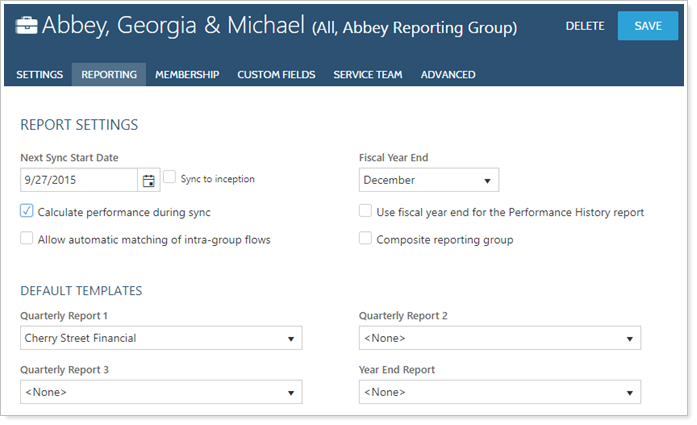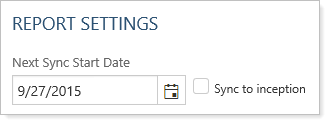Contents
Introduction
The Report Settings panel allows you to determine reporting group level reporting options such as fiscal year end dates, default templates, and sync start dates.

This panel is available under the Reporting menu when you edit a reporting group on the Accounts page. For more information on editing reporting groups, visit Creating and Modifying Reporting Groups.
See below for descriptions of each of the settings on the page.
Next Sync Start Date
This setting allows you to select how far back the next sync goes for the account. You can change this date to any date you want. You can also select the Sync to inception check box to set the sync date to the account inception date.

This setting allows you to make changes to individual accounts or reporting groups via sync while leaving the majority of your accounts to sync according your regular sync schedule. By leaving most of your accounts to sync on the standard schedule, you can keep sync times down while also updating individual accounts.
For example, if you notice a pricing error from a month ago in your portfolio accounting system for an account and you correct it in the portfolio accounting system, you want to ensure that the account syncs back to that correction. You can change the Next Sync Start Date to sync all the way back to the change.
This setting clears after the sync has occurred, so the account will not continue syncing back to that past date indefinitely.
Fiscal Year End
Select the month that the reporting group's fiscal year ends. Leave the default of December if the reporting group follows the calendar year.

You can also choose to Use fiscal year end for the Performance History report. Select this check box to use the fiscal year for the Performance History report. You will not see fiscal year mentioned on the report, but the quarterly and annual date periods will be adjusted to match the reporting group's fiscal year.
For more information on using this setting in the Performance History report, see Base Date Periods On.
Display Accrued Interest
Select this check box if, when calculating the value of this reporting group, you want to include interest accrued since the last interest payment. Interest is generated by bonds, CDs, and mortgage-backed securities.

Include Accrued Gains
Select this check box if, when calculating the value of this reporting group, you want to include gains accrued since the last interest payment.

Include Accrued Dividends
Select this check box if, when calculating the value of this reporting group, you want to include dividends accrued since the last interest payment.

Default Templates
Choose the default PDF templates for the reporting group.
Sometimes you need more than one default template. For example, you may need different default templates for tax returns, year-end reporting, and Q1, Q2 and Q3 reporting. Template Types allow you to specify default templates for each type of report you run. Once you set up your default templates for each template type, you can generate reports based on the template type.

For details on the template types, visit PDF Template Types.
For more information on creating, editing, or deleting PDF templates, see Create, Edit, and Delete a PDF Template.
Composite Reporting Group
Indicates whether a group is eligible for composite reporting as a single entity.
A group will not be valid for composites if it contains groups or if it contains accounts that are in other composite groups.
You won't have to worry about creating invalid composites because the check box will be grayed out if the group is not valid for a composite.
NOTE
You will only see this check box if your firm is enabled for composite reporting. To enable composite reporting for your firm, please contact Tamarac Account Management.


